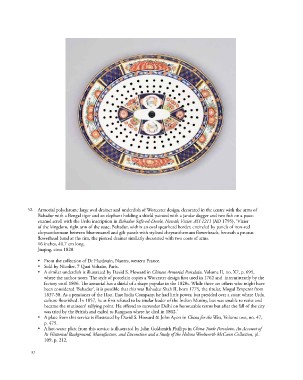Page 82 - Chinese Export Porcelain MARCHANT GALLERY 2015
P. 82
52. Armorial polychrome large oval drainer and underdish of Worcester design, decorated in the centre with the arms of
Bahadur with a Bengal tiger and an elephant holding a shield painted with a jandar dagger and two fish on a puce-
enamel scroll with the Urdu inscription in Bahadur Safa-ed-Dowle, Nawab, Vizier. AH 1211 (AD 1795), ‘Vizier
of the kingdom, right arm of the state, Bahadur, within an oval spearhead border, encircled by panels of iron-red
chrysanthemum between blue-enamel and gilt panels with stylised chrysanthemum flowerheads, beneath a prunus
flowerhead band at the rim, the pierced drainer similarly decorated with two coats of arms.
16 inches, 40.7 cm long.
Jiaqing, circa 1820.
• From the collection of Dr Hardouin, Nantes, western France.
• Sold by Nicolier, 7 Quai Voltaire, Paris.
• A similar underdish is illustrated by David S. Howard in Chinese Armorial Porcelain, Volume II, no. X7, p. 695,
where the author notes ‘The style of porcelain copies a Worcester design first used in 1762 and intermittently by the
factory until 1806. The armorial has a shield of a shape popular in the 1820s. While there are others who might have
been considered ‘Bahadur’, it is possible that this was Bahadur Shah II, born 1775, the titular, Mogul Emperor from
1837-58. As a pensioner of the Hon. East India Company, he had little power, but presided over a court where Urdu
culture flourished. In 1857, he at first refused to be titular leader of the Indian Mutiny, but was unable to resist and
became the mutineers’ rallying point. He offered to surrender Delhi on honourable terms but after the fall of the city
was tried by the British and exiled to Rangoon where he died in 1802.’
• A plate from this service is illustrated by David S. Howard & John Ayers in China for the West, Volume two, no. 47,
p. 475.
• A hot-water plate from this service is illustrated by John Goldsmith Phillips in China Trade Porcelain, An Account of
Its Historical Background, Manufacture, and Decoration and a Study of the Helena Woolworth McCann Collection, pl.
109, p. 212.
82

